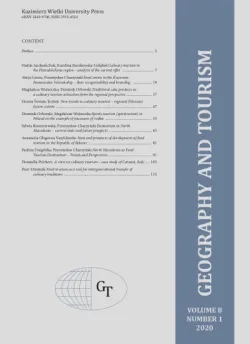Tourist routes as a tourism product stimulating the development of tourism in Poland
DOI:
https://doi.org/10.34767/GAT.2021.09.10Keywords:
tourist routes, tourist product, tourist development, Kcynia, PolandAbstract
Tourist routes combine cultural and natural heritage and are an inseparable element of tourism space and cultural landscape. In Poland the significance of tourist trails as a tourism product contributing to the development of the tourism economy has increased. The primary aim of this paper was to design a tourist trail combining natural and anthropogenic values. The research was conducted in the commune of Kcynia located in Kuyavian-Pomeranian voivodeship and consists of a town and 54 villages. The work makes use of the valorisation method, Wejchert’s impression curve. The results show that the Kcynia commune has sufficient natural and cultural values for developing tourism, but its tourism potential is not fully utilised in comparison with that of other communes. First of all, it lacks a well-developed tourism infrastructure. The proposed tourist routes would – in a relatively inexpensive and non-invasive way – enhance the potential and interest of the commune and improve the income of its inhabitants. In addition, it would raise interest in tourism and leisure tourism.
References
Bajerowski T., Biłozor A., Cieślak I., Senetra A., Szczepańska A. 2007. Ocena i wycena krajobrazu. Wydawnictwo Educaterra. Olsztyn.
Busby G., Klug J., 2001. Movie-Induced Tourism: The Challenge of Measurement and Other Issues. Journal of Vacation Marketing 7(4), 316-332. DOI: 10.1177/135676670100700403.
Dernoi L. A., 1991. Prospects of rural tourism: Needs and opportunities. Tourism Recreation Research 16(1), 89-94. Briedenhann J., 2000. An integrated tourism policy for South Africa: Problems and challenges, unpublished masters dissertation. Buckinghamshire Chiltern University College, High Wycombe.
Briedenhann J., Wickens E., 2004. Tourism routes as a tool for the economic development of rural areas-vibrant hope or impossible dream? Tourism Management 25(1), 71-7. DOI: 10.1016/S0261-5177(03)00063-3.
Broniewicz E., 2016. Analiza ex ante efektywności kosztowej polityki ekologicznej. Oficyna Wydawnicza Politechniki Białostockiej, Białystok [In Polish].
Duda T., 2018. The cultural heritage trail as a product identifying local identity and stimulating diversification of tourism activity in the region – on the example of creating Griffin Trail (Western Pomerania). Turystyka Kulturowa 4, 95-112.
Duda A., 2009. Przewodnik po miejscach pamięci gminy Kcynia. Urząd Miejski w Kcyni, Kcynia.
Duda T., Trocińska N., 2015. Poznaj smak pielgrzymowania – tradycje kulinarne i kreowanie nowych produktów na szlaku Pomorskiej Drogi Świętego Jakuba. [In:] Włodarczyk B., Stasiak A. (Eds.), Kultura i turystyka – wokół wspólnego stołu. Regionalna Organizacja Turystyczna Województwa Łódzkiego, Łódź, 291-313.
Earl B., 2008. Literary tourism: Constructions of value, celebrity and distinction. International Journal of Cultural Studies 11(40), 401-417.
Ewertowski M., Tomczyk A., 2007. GIS assessment of the state of the geographical environment along tourist trails for the integration and analysis of terrain and cartographical data. Przegląd Geograficzny 79(2), 271-295.
Falkowski J., 2017. Order and spatial disorder in the methodology od sustainable socio-economic development (on the example of Kujawsko-Pomorskie province). Rozwój Regionalny i Polityka Regionalna 38, 195–215.
Gibbons D., Hill B., Illum S., Var T., 1995. Building a sustainable World Through Tourism. Annals of Tourism Research 22(3), 701-702.
Gonia A., Charzyński P., 2020. Food events in Kuyavian-Pomeranian Province-its recognizability and branding. Geography and Tourism 8(1), 19-35.
Hudson S., Ritchie J. R. B., 2006. Promoting Destinations via Film Tourism: An Empirical Identification of Supporting Marketing Initiatives. Journal of Travel Research 44(4), 387-396.
Gordon H., Zielińska E., 2006. Kcynia. Wydawnictwo Graff – Press, Bydgoszcz.
Jastrzębski W., Romanowska-Grabowska O., Micner F., Janiszewska-Micner B., Perlińska A., Stankowski W., Ciżmowska A., Kuras Z., Marosz J., Prysak P., 1993. Dzieje Kcyni i okolic. Kcyńskie Towarzystwo Kulturalne, Wyd. Zarząd Gminy i Miasta, Kcynia, Kcynia.
Jezierska-Thöle A., Biczkowski M., Thöle M. 2018. Importance and role: “The way of Saint James” in the development of international tourism in border-adjacent areas of Poland and Germany. Ekonomiczne Problemy Turystyki 42, 195-207.
Jezierska-Thöle A., 2018. Development of rural areas of Northern and Western Poland and Eastern Germany. Wydawnictwo Naukowe Uniwersytetu Mikołaja Kopernika.
Jezierska-Thöle A., 2014. Development of international tourism in the border zone between Poland and Germany. [In:] Niezgoda A., Gołembski G., (Eds.), Turystyka wobec zmian współczesnego świata: strategia, marketing, programowanie. Wydawnictwo Uniwersytetu Ekonomicznego, Poznań, 358–376.
Kaczmarek J., Stasiak A., Włodarczyk B., 2009. Tourist product: idea, organization, management. Państwowe Wydawnictwo Ekonomiczne, Warszawa.
Kołodziejczyk K., 2015. Wzorce zagospodarowania szlaków turystycznych w górach średnich na wybranych przykładach europejskich. Uniwersytet Wrocławski, Wrocław, pp. 462.
Kruczek, Z., 2013. The importance of cultural routes for the development of educational tourism. Prace Naukowe Uniwersytetu Ekonomicznego we Wrocławiu 304, 124-133.
Makarewicz J., 2012. Z archiwum pamięci – obraz Kcyni we wspomnieniach mieszkańców. Wydawnictwo Pejzaż, Bydgoszcz.
Ngamsomsuke W., Hwang T., Huang C., 2011. Sustainable Cultural Heritage Tourism Indicators. International Conference on Social Science and Humanity IPEDR, IACSIT Press, Singapore, 516-520.
Orzechowska-Kowalska K., 2003. Creating European Cultural Routes. Turyzm 2(13), 69–78.
Pigan M., 2009. Significant role of the State Forests in propagation of the forest and nature tourism. Studia i materiały Centrum Edukacji Przyrodniczo-Leśnej 11(4), 23.
Rosenfeld R.A., 2008. Cultural and Heritage Tourism, Municipal Economic Development Tools. Michigan State University, Michigan.
Selin S., Friman A., 2002. Cross-border cooperation: sustainable tourism partnerships in Russian Karelia. In Tourism and Wellbeing. The 2nd Tourism Industry and Education Symposium, Jyvaskyla, Finland, May, 16-18.
Sewerniak J., 1982. Problematyka zagospodarowania programowo – przestrzennego szlaków turystyki pieszej. Problemy Turystyki 4(18), 30–54.
Stasiak A., 2006. Produkt turystyczny – szlak. Turystyka i Hotelarstwo. Wydawnictwo Wyższa Szkoła Turystyki i Hotelarstwa 10, 9-40.
Szudrowicz A., 1996. Kcynia. Szkice z historii miasta i okolic. Wyd. Urząd Miasta i Gminy w Kcyni, Kcyinia.
Rogowski M., 2018. Use of Monitoring System of tourist traffic (MStt) in Stołowe Mts. National Park for visitors description. Journal of the Polish Association of Environmental and Resource Economists 2(65), 87–98.
Wojciechowska J., 2003. Cultural heritage of regions as an element of a tourist product. [In:] Burzyński T., Łabaj M. (Eds.), Turystyka rekreacyjna oraz turystyka specjalistyczna, projekt SAPARD, Biuro Ekspertyz Finansowych, Marketingu i Consultingu Uniconsult, Warszawa, 152-159.

